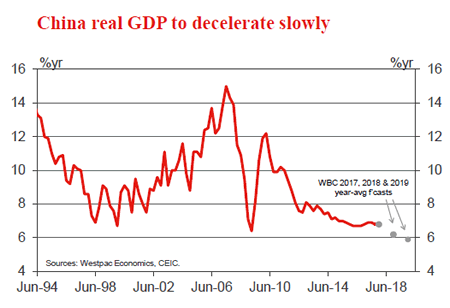Week beginning 15 January 2018
- ‘The week that was’, data previews, calendar and forecasts.
- Australia: Westpac-MI Consumer Sentiment, employment, housing finance.
- NZ: house sales & prices, retail card spending, Survey of Business Opinion.
- China: Q4 GDP, fixed asset investment, retail sales, industrial production.
- US: housing starts & permits, Beige Book, University of Michigan consumer sentiment.
- Central banks: BoC policy decision.
- Key economic & financial forecasts.
Information contained in this report was current as at 12 January 2018.
The week that was
Data releases for Australia at the beginning of 2018 have delivered a number of surprises. Most notable amongst these have been surging dwelling approvals and retail sales.
Starting with dwelling approvals, against October’s flat outcome and the market’s November expectation of a 1% fall, the near 12% gain was certainly eye catching. Interestingly, it was in large part due to a jump in Victorian approvals, a 38% surge following October’s 21% jump. Both of these outcomes came as a result of strength in the highly-volatile high-rise apartment category. In stark contrast to the goings on in Victoria, approvals were little changed elsewhere, falling 2% in the month following an 8% decline in October. The trend for detached dwellings remains far more muted: they fell 2% in the month to be only 2% higher than a year ago. Overall, the November report points to the housing construction cycle having more enduring strength than anticipated. However, we still believe that we are past the peak in activity. Hence, GDP growth is unlikely to receive lasting support from the sector. Given the very volatile nature of this data, a large downside ‘surprise’ in coming months seems highly likely.
Moving then to retail sales, a 1.2% surge was reported in November – three times the gain the market had expected. For further detail, see chart of the week below.
While a week old, it is also worth mentioning that the Australian trade deficit was larger than anticipated in November (-$0.6bn) and that the October result was also revised down (from +$0.1bn to -$0.3bn). For the most part, this downside surprise looks to have been driven by the commodity sector, particularly gold in November. Consumption good imports did rise, but not in scale consistent with the above retail sales surge. One suspects therefore that November’s retail sales outcome will be followed by stronger consumer imports come the December trade report. Needless to say, direct imports of consumer goods from offshore merchants are of no benefit to our own economy, as the income spent flows straight out of the country.
Moving offshore, to date in 2018 it has been financial markets that have been the focus rather than economic data. The one ‘economic event’ of note is the minutes of the ECB’s last policy meeting. These carried a very positive tone as growth remained strong and confidence at record highs. Yet their optimism remained conditional on a policy stance in "crisis configuration" (that is, extraordinarily easy monetary policy). In time, an increasingly self-sustaining growth cycle will see the ECB Governing Council bring asset purchases to an end, and plans to raise rates come to light. We see the first event as occurring at the end of the year (or, if conditions improve further, potentially at the current program’s September end date), but the latter not until well into 2019. In the interim, from as early as the next policy meeting, a gradual firming of the language used to describe the economy will be seen to slowly ‘make known’ to the market the ECB’s intent. It has to be said though, given the Euro’s gains against the US dollar during the past month, the market looks to have already pre-empted this shift in forward guidance.
Finally on the US, little has changed since late-2017. Debate on the effectiveness of the now-passed tax bill continues to rage on. On the one hand are comments such as those of Atlanta Fed President Bostic: "among businesses surveyed after the House of Representatives’ version of the tax overhaul had been approved, two-thirds or more of larger firms said the changes would not prompt them to expand investment or hiring". But on the other are individual company decisions such as that made by Walmart to increase the hourly wage paid to their lowest-paid workers from February, from $9-10 to $11. Suffice to say that the US economy is very large and the tax package very complex; ergo, the net aggregate effect will take considerable time to digest. Regarding the FOMC, the positive tone of financial markets generally in early 2018 has rubbed off on market expectations for the next Fed hike. The market’s view on the timing is that it is now most likely to come in March, and definitely by June (on economic fundamentals, June remains our current expectation). Interestingly, the best guess of the market on the total number of hikes in 2018 is still that there will only be two (also our view). However, it is evident that financial conditions are becoming the swing variable for policy, both in terms of the timing of each decision and whether the cumulative number of hikes will be two (as we and the market expect), three (the FOMC’s central forecast) or more.
Chart of the week: November Australian retail sales
Retail sales surged 1.2% in November, well in excess of expectations for a 0.4% rise. Annual growth is at 2.9%yr.
The result reflects a strong consumer response to emerging sales events, namely the Black Friday sales, with a boost in spending across household goods – in particular electronics – as well as the ‘other retailing’ category. These relatively new events in Australia may be causing a behavioural change in the way consumers shop, postponing purchases in the run up to expected discount periods. That effect appears to not yet be fully captured in seasonal adjustments to the sales data. This dynamic is likely to be behind the increased volatility in the retail sales series of late with Q4 bouncing back from a soft Q3.
Nevertheless, underlying fundamentals for the consumer are still subdued with weak household income growth a constraint on spending. But with the unveiling of Amazon’s expanded catalogue a factor in the next December release, there will likely continue to be higher volatility in upcoming retail sales data.

Data Previews
Aus Jan Westpac-MI Consumer Sentiment
Jan 17 Last: 103.3
The Westpac-Melbourne Institute Consumer Sentiment Index rose 3.6% to 103.3 in December from 99.7 in November. The average reading for the Index in the December quarter was 5% above the average for the September quarter when we saw a disturbing slump in consumer spending.
The Jan survey is in the field over the week ended Jan 13. Note that the headline is adjusted to remove a regular ‘holiday’ sentiment bump worth about 4pts. Other factors that may influence confidence this month include: another strong gain in jobs; but more signs of cooling across Australia’s housing markets. Australia’s dominance in the Ashes may also add to the Christmas mood.
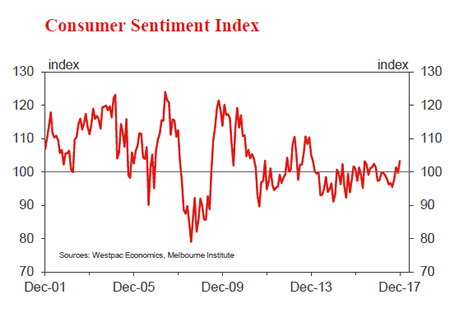
Aus Nov housing finance (no.)
Jan 17, Last: 0.6%, WBC f/c: -1.0%
Mkt f/c: 0.0%, Range: -1.0% to 1.5%
- Housing finance approvals have held up much better than expected given the material housing market slowdown evident in auction clearance rates, prices and turnover. The total number of owner occupier finance approvals dipped 0.6% in Oct, down 0.8% ex refi. The value of investor housing finance posted a 1.6% rise despite multiple downward pressures.
- The Nov update should show a decline. Markets have yet to level out and although the initial adjustment to APRA’s macroprudential restrictions have largely passed, we expect some restraint to still be evident. Approvals are expected to decline 1%.

Aus Dec Labour Force – employment ‘000
Jan 18, Last: 61.6k, WBC f/c: -10k
Mkt f/c: 15k, Range: -10k to 40k
- Total employment rose 61.6k compared the market’s 19k forecast and Westpac’s +25k. It was the 14th consecutive gain monthly gain in employment matching the historical second longest period of monthly gains which started Aug 1979. The longest period of consecutive employment gains is 15 months starting May 1993.
- The Australian labour market gathered momentum through 2017 with annual employment growth accelerating from 0.9%yr in February to the November peak of 3.2%yr. In the year to Nov total employment has grown 383.3k.
- The pace of employment growth overshot Westpac Jobs Index which is suggesting growth of around 2¾%yr. The Jobs Index is not pointing to a downturn, however, growth is likely to ease back from the +3%yr pace. Westpac’s -10k forecast will see it ease to a 2.9%yr pace.
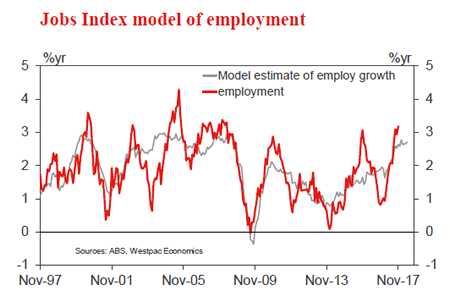
Aus Dec Labour Force – unemployment %
Jan 18, Last: 5.4%, WBC f/c: 5.5%
Mkt f/c: 5.4%, Range: 5.3% to 5.5%
- In November the unemployment was flat at 5.4% (5.40% at two decimal places vs. 5.39% in October) with a 0.3ppt gain participation driving 65.7k surge in the labour force.
- In the November survey the ABS noted that the incoming rotation group had a higher employment to population ratio than both the group it replaced and the entire sample. As such, sample volatility would explain a fair proportion of both the rise in employment and participation in November and thus the flat unemployment rate.
- For December we are expecting a more average sample to roll in which should result in both a lower employment to population ratio and participation rate. This should limit the rise in the unemployment rate to 5.5% despite the 10k dip in employment.
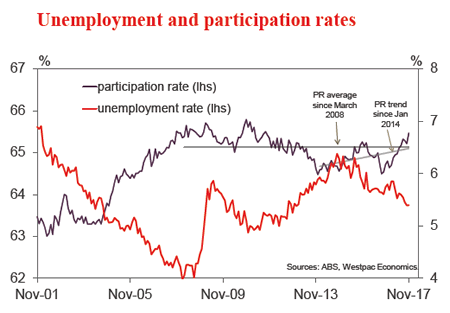
NZ Dec house sales and prices
Jan 15, Sales last: +4.1%, Prices last; +3.5%yr
- The housing market picked up in late 2017, with lower borrowing rates boosting both prices and sales. This reversed some of the softening we saw earlier in the year.
- We expect the positive trend in the housing market to continue for a few more months as buyers rush to beat looming regulatory and tax changes, as mortgage rates fall, and as banks loosen lending requirements following the RBNZ’s LVR changes.
- However, over the course of 2018 we expect that changes in Government policy will see the market slow again.
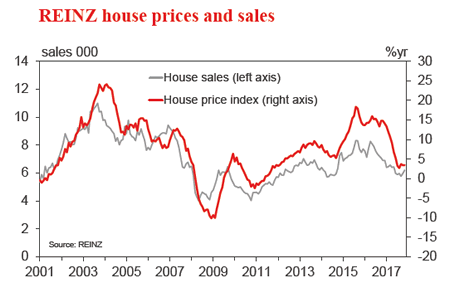
NZ Dec retail card spending
Jan 16, Last: +1.2%, WBC f/c: +0.5%
- Retail card spending rose strongly in November, increasing 1.2%. In part, this was due to increases in fuel prices. However, there were also solid gains in core spending categories, supported by the lift in the housing market and growing prevalence of ‘Black Friday’ sales.
- Some of the strength that we saw in November reflects that spending was brought forward to take advantage of price discounting, particularly in the case of durable goods. As a result, some payback is expected in December. Balanced against this, late-2017 has seen a second wind in the house housing market, which will provide some boost to spending. Weighing these factors up, we expect a modest 0.5% gain in retail spending in December.
- Heading in 2018, the strength of spending will be challenged by policies aimed at dampening housing market pressures and the gradual slowing in population growth.

NZ Quarterly Survey of Business Opinion
Jan 16, Domestic trading activity – last: +27
- The previous survey of business opinion was conducted ahead of September’s election. It showed that businesses had become increasingly nervous about the broader economic environment. However, they were still fairly upbeat about the prospects for activity in their own firms.
- Three months on, and with a change in Government, it’s likely that confidence has taken a further hit. We’ll be watching to see how this is affecting businesses’ hiring and investment intentions, with other recent surveys pointing to softening activity.
- We’ll also be keeping a close eye on the survey’s key activity gauges. In particular, we’ll be watching how activity in the construction sector is shaping up, and any headwinds that the industry is highlighting. We’ll also be watching for signs that capacity or inflation pressures are increasing.

China Q4 GDP
Jan 18, last 6.8%, WBC 6.7%
- China GDP has consistently beaten expectations through 2017, spurred on by external demand as well as a robust pipeline of investment projects that are proceeding to completion.
- It may again be the case that growth surprises to the upside; however, we and the market believe the more likely outcome is that momentum slows a tick from 6.8%yr to 6.7%yr.
- The basis of this view is partly attributable to the slowdown in investment currently being seen across the economy, in both residential and nonresidential construction as well as other investment spending being undertaken by the government and corporates.
- Also key to the growth story is the consumer. Here we see robust demand, but not enough of an acceleration to more than offset the softening investment pulse.
